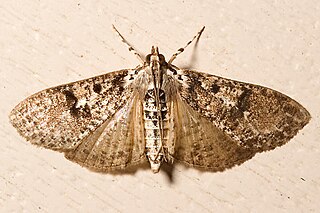
Palpita vitrealis, common name jasmine moth or white pearl, is a species of moth of the family Crambidae.

Palpita is a genus of moths of the family Crambidae. Members of the moth genus Stemorrhages may be very similar in appearance.

Palpita arsaltealis is a moth of the family Crambidae first described by Francis Walker in 1859. It is found in the north-eastern United States, south to South Carolina. It is also present in Quebec and Ontario.

Diaphania indica, the cucumber moth or cotton caterpillar, is a widespread but mainly Old World moth species. It belongs to the grass moth family, and therein to the large subfamily Spilomelinae. This moth occurs in many tropical and subtropical regions outside the Americas, though it is native to southern Asia; it is occasionally a significant pest of cucurbits and some other plants.

Palpita nigropunctalis, the lilac pyralid, is a moth of the family Crambidae. It is found in eastern Asia, including China, Taiwan, Korea, Japan and the Russian Far East.

Palpita maritima is a moth in the family Crambidae. The species was first described by J. Bolling Sullivan and Maria Alma Solis in 2013. It is found in the United States in Alabama, North Carolina and Florida. The habitat consists of coastal maritime forests.

Palpita pudicalis is a species of moth of the family Crambidae. It was described by George Hamilton Kenrick in 1907 and is found in Papua New Guinea.

Diaphania costata, the orange-shouldered sherbet moth or erroneously the white palpita moth, is a moth of the family Crambidae. The species was first described by Johan Christian Fabricius in 1794. It is widely dispersed, being found in the Indomalayan realm, as well as Europe. It is also found in Mexico and Texas, possibly having been introduced accidentally.
Palpita elealis is a moth in the family Crambidae. It was described by Francis Walker in 1859. It is found in Cameroon, the Republic of the Congo, the Democratic Republic of the Congo, Ghana, Ivory Coast, Sierra Leone, South Africa, São Tomé and Príncipe, the Gambia, Zambia and Zimbabwe.
Palpita kiminensis is a moth in the family Crambidae. It was described by Jagbir Singh Kirti and H. S. Rose in 1992. It is found in north-eastern India, China, Nepal, Myanmar, Thailand, Vietnam, Borneo, Sumatra and northern Australia.
Palpita kimballi, or Kimball's palpita moth, is a moth in the family Crambidae. It was described by Eugene G. Munroe in 1959. It is found in North America, where it has been recorded from Alabama, Florida, Georgia, Louisiana, North Carolina, Oklahoma, South Carolina, Tennessee and Virginia.

Palpita freemanalis, or Freeman's palpita moth, is a moth in the family Crambidae. It was described by Eugene G. Munroe in 1952. It is found in North America, where it has been recorded from Alabama, Illinois, Indiana, Louisiana, Maryland, Mississippi, North Carolina, Oklahoma, South Carolina, Tennessee and Texas.
Palpita curvispina is a moth in the family Crambidae. It was described by Zhang and Li in 2005. It is found in China.
Palpita illibalis, the inkblot palpita moth, is a moth in the family Crambidae. It was described by Jacob Hübner in 1818. It is found in North America, where it has been recorded from Alabama, Florida, Georgia, Maryland, Mississippi, North Carolina, Ohio, Oklahoma, Pennsylvania, South Carolina, Tennessee, Virginia and West Virginia.
Palpita pajnii is a moth in the family Crambidae. It was described by Jagbir Singh Kirti and H. S. Rose in 1992. It is found in China, Taiwan, Vietnam, Thailand, Myanmar, Indonesia, the Philippines, India, Nepal, Australia (Queensland), Norfolk Island and Papua New Guinea.
Palpita metallata is a moth in the family Crambidae. It is found in Cameroon, Mayotte, Democratic Republic of Congo, Ghana, Kenya, Nigeria, Sierra Leone, South Africa, Tanzania and Uganda.

Palpita quadristigmalis, the four-spotted palpita moth, is a moth in the family Crambidae. It is found in North America, where it has been recorded from Quebec and Ontario to Florida, west to Arizona and north to Colorado.
Palpita spilogramma is a moth in the family Crambidae. It is found in Fiji.
Palpita vitiensis is a moth in the family Crambidae. It was described by John Clayton in 2008 and is found on Fiji.










